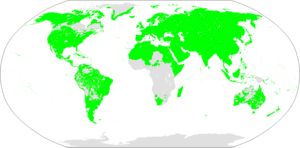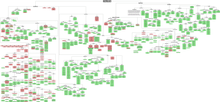Borean languages
Borean (also Boreal or Boralean)[1] is a hypothetical linguistic macrofamily that encompasses almost all language families worldwide except those native to sub-Saharan Africa, New Guinea, Australia, and the Andaman Islands. Its supporters propose that the various languages spoken in Eurasia and adjacent regions have a genealogical relationship, and ultimately descend from languages spoken during the Upper Paleolithic in the millennia following the Last Glacial Maximum. The name Borean is based on the Greek βορέας, and means "northern". This reflects the fact that the group is held to include most language families native to the northern hemisphere. Two distinct models of Borean exist: that of Harold C. Fleming and that of Sergei Starostin.
| Borean | |
|---|---|
| (hypothetical, fringe) | |
| Geographic distribution | Eurasia, sometimes the Americas |
| Linguistic classification | Proposed language family |
| Subdivisions |
|
| Glottolog | None |
 Borean macro-family according to Harold C. Fleming | |
Fleming's model
The concept is due to Harold C. Fleming (1987), who proposed such a "mega-super-phylum" for the languages of Eurasia, termed Borean or Boreal in Fleming (1991) and later publications. In Fleming's model, Borean includes ten different groups: Afrasian (his term for Afroasiatic), Kartvelian, Dravidian, a group comprising Sumerian, Elamitic, and some other extinct languages of the ancient Near East, Eurasiatic (a proposal of Joseph Greenberg that includes Indo-European, Uralic, Altaic, and several other language families), Macro-Caucasian (a proposal of John Bengtson that includes Basque and Burushaski), Yeniseian, Sino-Tibetan, Na-Dene, and Amerind.[2]
Fleming writes that his work on Borean is inspired by Greenberg's exploration of Eurasiatic, and is oriented towards the concept of "valid taxon". He rejects Nostratic, a proposed macrofamily somewhat broader than Eurasiatic, and withholds judgment on Dené–Caucasian, a proposal that would encompass Sino-Tibetan, Yeniseian, Basque, and several other language families and isolates. Fleming calls Borean a "phyletic chain" rather than a super-phylum. He notes that his model of Borean is similar to Morris Swadesh's Vasco-Dene proposal, although he also sees similarities between Vasco-Dene and Dené–Caucasian. He sees Borean as closely associated with the appearance of the Upper Paleolithic in the Levant, Europe, and western Eurasia from 50 thousand to 45 thousand years ago, and observes that it is primarily associated with human populations of Caucasoid and Northern Mongoloid physical appearance, the exceptions being southern India, southern China, southwestern Ethiopia, northern Nigeria, and the Chad Republic.[2]
Starostin's model

As envisaged by Sergei Starostin (2002), Borean is divided into two groups, Nostratic (sensu lato, consisting of Eurasiatic and Afroasiatic) and Dene–Daic, the latter consisting of the Dené–Caucasian and Austric macrofamilies.[3] Starostin tentatively dates the Borean proto-language to the Upper Paleolithic, approximately 16 thousand years ago. Starostin's model of Borean would thus include most languages of Eurasia, as well as the Afroasiatic languages of North Africa and the Horn of Africa, and the Eskimo–Aleut and the Na-Dene languages of the New World.
Murray Gell-Mann, Ilia Peiros, and Georgiy Starostin maintain that the comparative method has provided strong evidence for some linguistic superfamilies (Dené-Caucasian and Eurasiatic), but not so far for others (Afroasiatic and Austric). Their view is that since some of these families have not yet been reconstructed and others still require improvement, it is impossible to apply the strict comparative method to even older and larger groups. However, they consider this only a technical rather than a theoretical problem, and reject the idea that linguistic relationships further back in time than 10,000 years before the present cannot be reconstructed, since the "main objects of research in this case are not modern languages, but reconstructed proto-languages which turn out to be more similar to one another than their modern day descendants"[1]. They believe that good reconstructions of superfamilies such as Eurasiatic will eventually help in investigating still deeper linguistic relationships. While such 'ultra-deep' relationships can currently be discussed only on a speculative level, they maintain that the numerous morphemic similarities between language families of Eurasia, many of which Sergei Starostin compiled into a special database that he later supplemented by his own findings, are unlikely to be due to chance, making it possible to formulate a Borean super-superfamily hypothesis.[4]
They have also suggested possible links between 'Borean' and other families. In their view comparisons with 'Borean' data suggest that Khoisan cannot be included within it but that more distant connections on an even deeper level might be possible, that how the African superfamilies Niger–Congo, East Sudanic, Central Sudanic and Kordofanian are related to Borean remains to be investigated, that the situation with the native languages of the Americas remains unresolved, and that while there are some lexical similarities between Borean and the Trans–New Guinea languages, these remain too scarce to establish a firm connection. They comment that while preliminary data indicates possible connections between Borean and some superfamilies from Africa, the Americas, and the Indo-Pacific region further research is needed to determine whether these additional superfamilies are related to Borean or unidentified branches of it.[4] Gell-Mann et al. note that their proposed model of Borean differs significantly from that of Fleming.[4]
Sergei Starostin died prematurely in 2005 and his hypothesis remains in a preliminary form, with much of the material he collected available online.[5][6]
The phylogenetic composition of Borean according to Starostin is as follows:
- "Borean"
- Nostratic (speculative, Holger Pedersen 1903)
- Indo-Uralic (speculative, Joseph Greenberg 2000)
- Indo-European (widely recognized family)
- Altaic (widely rejected; Roy Andrew Miller 1971, Gustaf John Ramstedt 1952, Matthias Castrén 1844)
- Uralic (widely recognized family)
- Yukaghir (language isolate)
- Paleosiberian (phylogenetic unity widely rejected)
- Eskimo–Aleut (widely recognized family)
- Chukotko-Kamchatkan (widely recognized family)
- Sumer-Elamite (widely recognized family)
- Kartvelian (widely recognized family)
- Dravidian (widely recognized family)
- Afroasiatic (widely recognized family)
- Indo-Uralic (speculative, Joseph Greenberg 2000)
- Dene–Daic (speculative, Starostin 2005)
- Dené–Caucasian (speculative, Nikolayev 1991; expanded by Bengtson 1997), cf. Dené–Yeniseian (Edward Vajda 2008)
- Yeniseian (widely recognized family)
- Na-Dené (widely recognized family)
- Iberian (language isolate)
- Basque (language isolate)
- Sino-Caucasian (speculative, Starostin 2006)
- Sino-Tibetan (widely recognized family)
- Burushaski (language isolate)
- North Caucasian (widely recognized family)
- Hattic (language isolate)
- Hurro-Urartian (widely recognized family)
- Austric (speculative, Wilhelm Schmidt 1906)
- Austro-Tai (speculative, Paul Benedict 1942)
- Austronesian (widely recognized family)
- Tai–Kadai (widely recognized family)
- Miao–Yao (widely recognized family)
- Austroasiatic (widely recognized family)
- Austro-Tai (speculative, Paul Benedict 1942)
- Dené–Caucasian (speculative, Nikolayev 1991; expanded by Bengtson 1997), cf. Dené–Yeniseian (Edward Vajda 2008)
- Nostratic (speculative, Holger Pedersen 1903)
Status of the hypothesis
Asya Pereltsvaig states in Languages of the World: An Introduction that both versions of the Borean hypothesis are "controversial and tentative".[7]
See also
- Proto-Human language
- List of proto-languages
- Haplogroup F (Y-DNA)
Notes
- http://ehl.santafe.edu/EhlforWeb.pdf
- Harold Fleming (2002) "Afrasian and Its Closest Relatives: the Borean Hypothesis", Global Perspectives on Human Language
- "Archived copy" (PDF). Archived from the original (PDF) on 2011-07-26. Retrieved 2010-10-29.CS1 maint: archived copy as title (link) George van Driem (2006) "Sino-Austronesian vs. Sino-Caucasian, Sino-Bodic vs. Sino-Tibetan, and Tibeto-Burman as Default Theory", Contemporary Issues in Nepalese Linguistics, Kathmandu: Linguistic Society of Nepal.
- Murray Gell-Mann et al. (2009) "Distant Language Relationship: The Current Perspective", Journal of Language Relationship·Вопросы языкового родства
- Alicia Sanchez-Mazas (ed.), Past human migrations in East Asia: matching archaeology, linguistics and genetics, Volume 5 of Routledge studies in the early history of Asia, Taylor & Francis, 2008, ISBN 978-0-415-39923-4, obituary, p. xxvi.
- Starostin's site includes a tree diagram with a hypothesized branching chronology for Borean, Sergei Starostin. "Borean tree diagram"., a database of proposed etymologies, "Description of database of suggested Borean etymologies"., "Online query of database of long-range etymologies".
- Pereltsvaig, Asya (2012-02-09). Languages of the World: An Introduction. Cambridge University Press. ISBN 9781107002784.
References
- H. C. Fleming, 'A New Taxonomic Hypothesis: Borean or Boralean', Mother Tongue 14 (1991).
- H. C. Fleming, 'Proto-Gongan Consonant Phonemes: Stage One', in Mukarovsky (ed.) FS Reinisch (1987), 141-159.